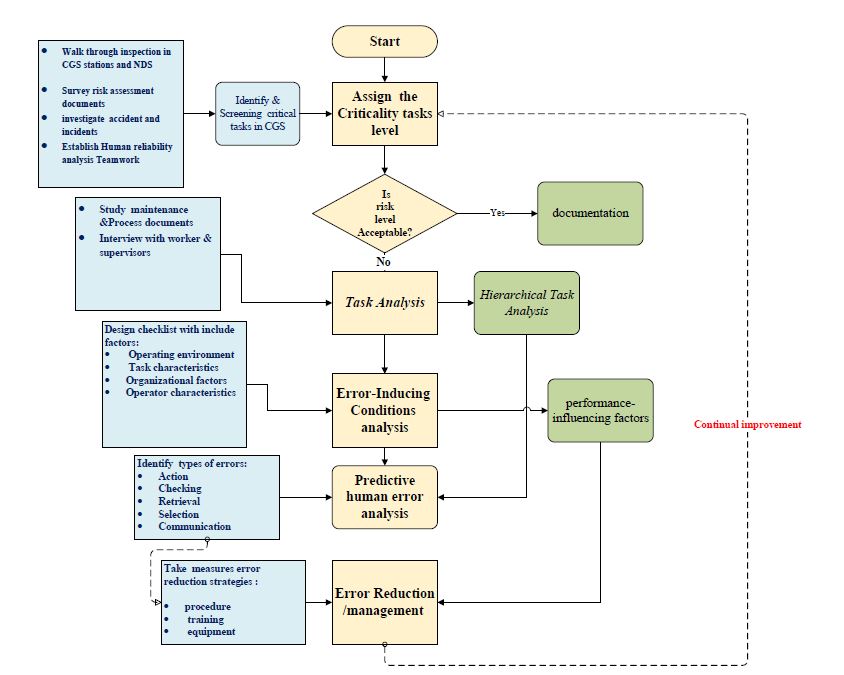Volume 12, Issue 4 (12-2022)
J Health Saf Work 2022, 12(4): 930-947 |
Back to browse issues page
Download citation:
BibTeX | RIS | EndNote | Medlars | ProCite | Reference Manager | RefWorks
Send citation to:



BibTeX | RIS | EndNote | Medlars | ProCite | Reference Manager | RefWorks
Send citation to:
Fooladi R, Karimi A, Mazloumi A, Sharif Rohani M, Hokmabadi R. Human Error Assessment in City Gate Stations of Isfahan Natural Gas Company Using the System for Predictive Error Analysis and Reduction Framework. J Health Saf Work 2022; 12 (4) :930-947
URL: http://jhsw.tums.ac.ir/article-1-6779-en.html
URL: http://jhsw.tums.ac.ir/article-1-6779-en.html
1- Department of Occupational Health Engineering, School of health, Tehran University of medical sciences, Tehran, Iran
2- Department of Occupational Health Engineering, School of health, Tehran University of medical sciences, Tehran, Iran ,a_karimi@sina.tums.ac.ir
3- Safety and fire manager, Department of HSE, Natural Gas Company, Esfahan, Iran
4- Department of Occupational Health Engineering, Faculty of Health, Tehran University of Medical Sciences, Tehran, Iran. Faculty member of Health School, North Khorasan University of Medical Sciences, Bojnurd, Iran
2- Department of Occupational Health Engineering, School of health, Tehran University of medical sciences, Tehran, Iran ,
3- Safety and fire manager, Department of HSE, Natural Gas Company, Esfahan, Iran
4- Department of Occupational Health Engineering, Faculty of Health, Tehran University of Medical Sciences, Tehran, Iran. Faculty member of Health School, North Khorasan University of Medical Sciences, Bojnurd, Iran
Abstract: (1261 Views)
Introduction: Human factor analysis has been identified as the most common cause of accidents in natural gas transportation and distribution facilities. The occurrence of accidents at these systems, especially gas reduction stations located in residential and industrial areas, has had catastrophic consequences. Therefore, this study aimed at analyzing critical tasks and human error assessment using the system for predictive error analysis and reduction (SPEAR) method and providing the appropriate framework for error management in the operation and maintenance of city gate stations.
Material and Methods: This descriptive cross-sectional study was conducted using the SPEAR framework and safety critical task analysis guideline to evaluate errors in gas pressure reduction stations. First, critical tasks were screened and evaluated, followed by performing task analysis by the hierarchical task analysis and detecting performance-influencing factors (PIF). Then, human errors were predicted and assessed based on the predictive human error analysis. Finally, error management was developed at three process, equipment, and training improvement levels.
Results: In general, out of 23 operations and 164 sub-tasks, 12 critical tasks were identified based on the results. Criticality level percentages were about 67% high risk, 25% moderate, and 8% low risk. In addition, 134 errors were identified which were mostly related to action (42.53%) and checking (39.55%) errors, respectively. Eventually, communication, retrieval, and selection errors were 8.96, 5.22, and 3.74%, respectively.
Conclusion: The results revealed that action and checking errors had the highest percentages. This method can be applied to appropriate the systems approach to error reduction using the PIF assessment output. The privilege affecting factors include preparing standard operation procedures, implementing a comprehensive training program, and controlling environmental hazards.
Material and Methods: This descriptive cross-sectional study was conducted using the SPEAR framework and safety critical task analysis guideline to evaluate errors in gas pressure reduction stations. First, critical tasks were screened and evaluated, followed by performing task analysis by the hierarchical task analysis and detecting performance-influencing factors (PIF). Then, human errors were predicted and assessed based on the predictive human error analysis. Finally, error management was developed at three process, equipment, and training improvement levels.
Results: In general, out of 23 operations and 164 sub-tasks, 12 critical tasks were identified based on the results. Criticality level percentages were about 67% high risk, 25% moderate, and 8% low risk. In addition, 134 errors were identified which were mostly related to action (42.53%) and checking (39.55%) errors, respectively. Eventually, communication, retrieval, and selection errors were 8.96, 5.22, and 3.74%, respectively.
Conclusion: The results revealed that action and checking errors had the highest percentages. This method can be applied to appropriate the systems approach to error reduction using the PIF assessment output. The privilege affecting factors include preparing standard operation procedures, implementing a comprehensive training program, and controlling environmental hazards.
Keywords: Human Error Assessment, Predictive Human Error Analysis, System for Predictive Error Analysis and Reduction, Safety Critical Task Analysis, City Gate Stations
Type of Study: Research |
Received: 2022/12/26 | Accepted: 2022/12/31 | Published: 2022/12/31
Received: 2022/12/26 | Accepted: 2022/12/31 | Published: 2022/12/31
Send email to the article author
| Rights and permissions | |
 |
This work is licensed under a Creative Commons Attribution-NonCommercial 4.0 International License. |







